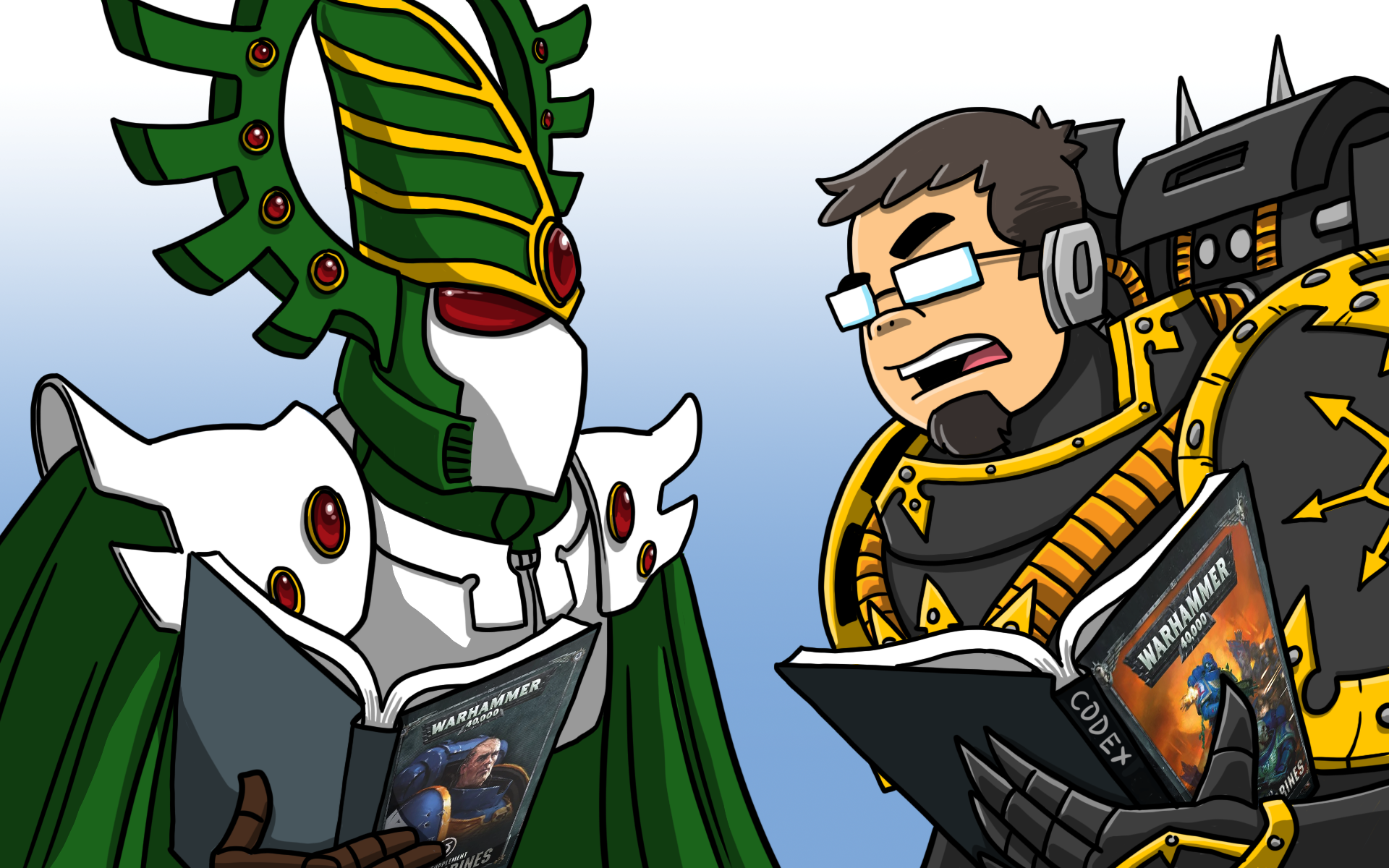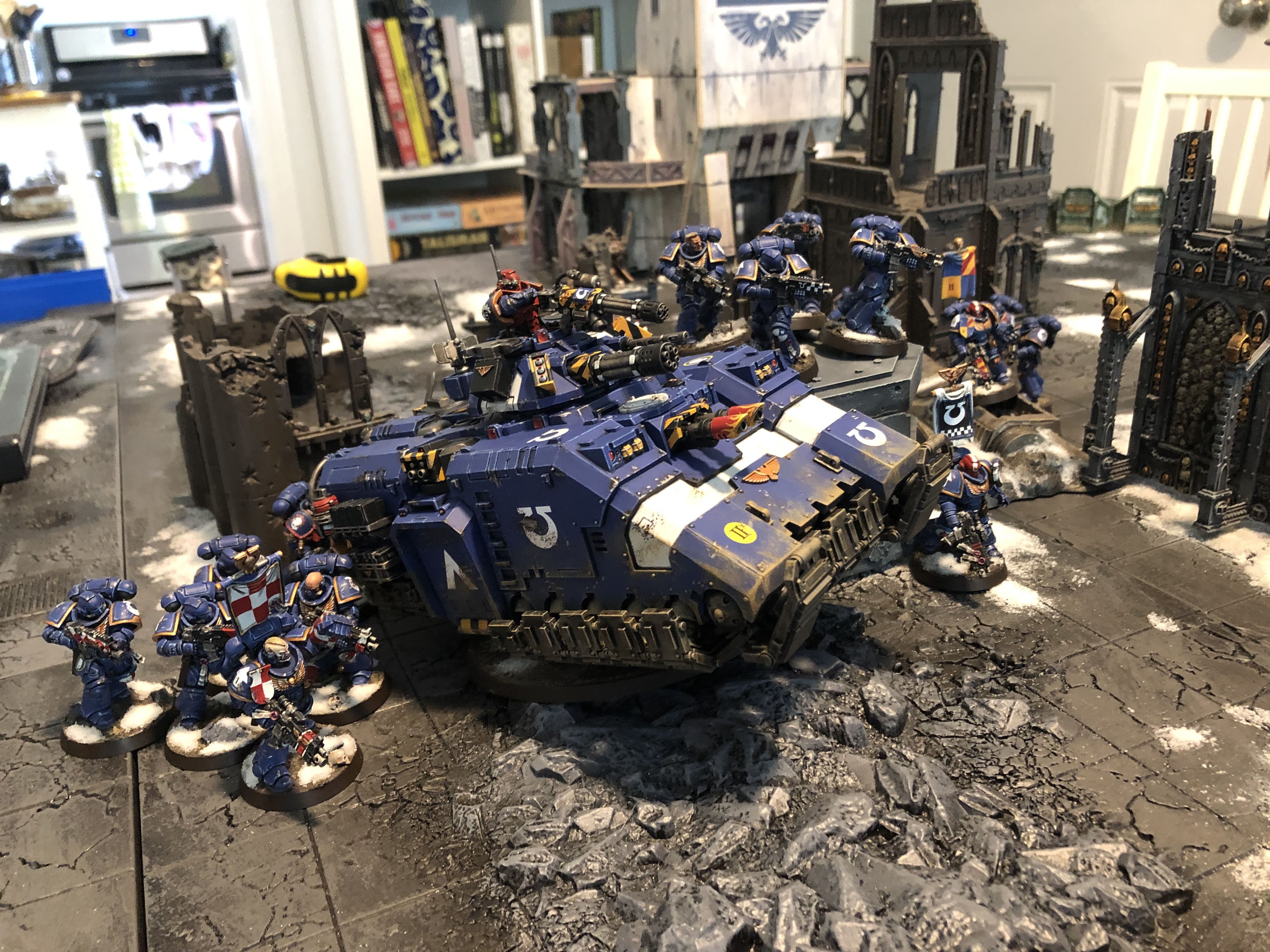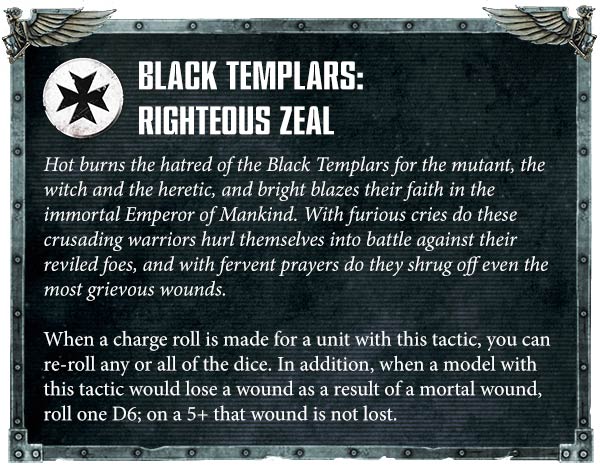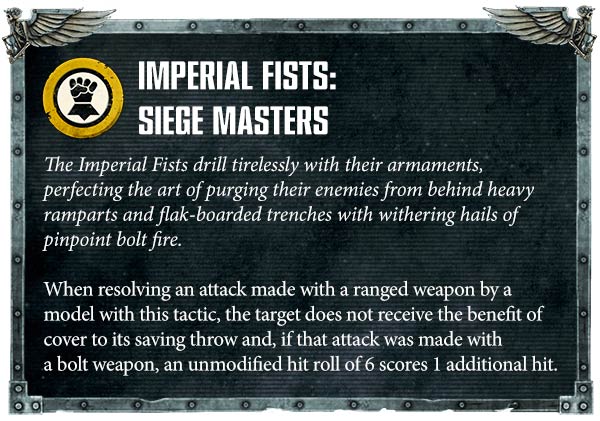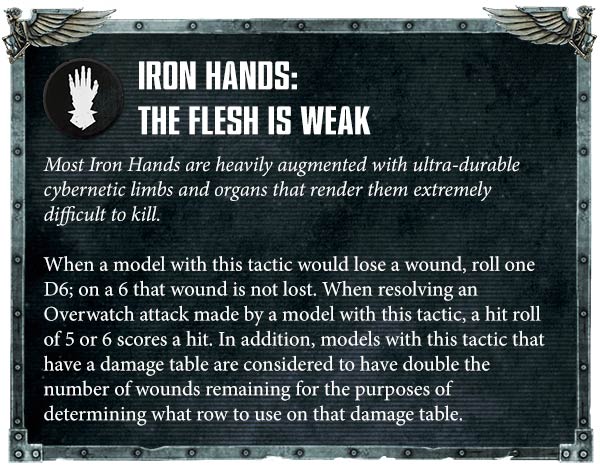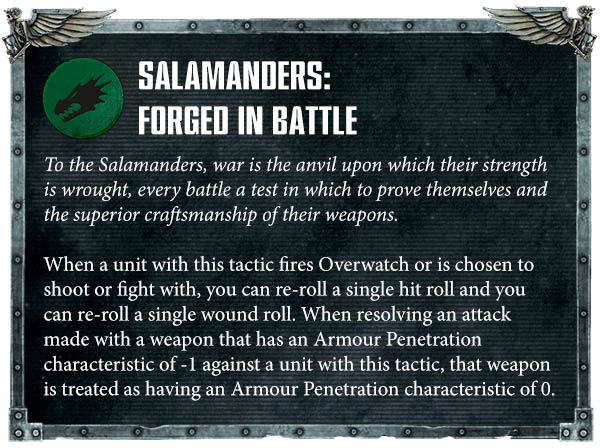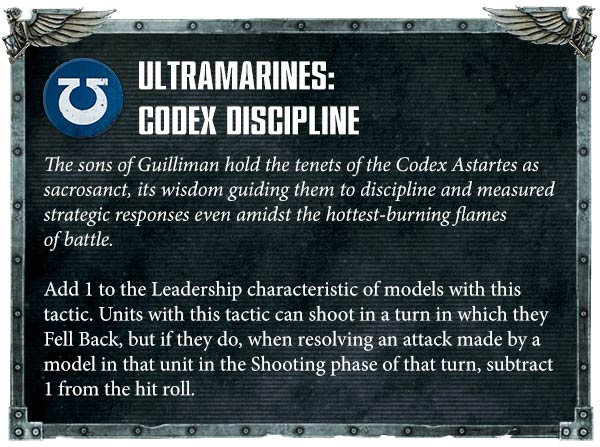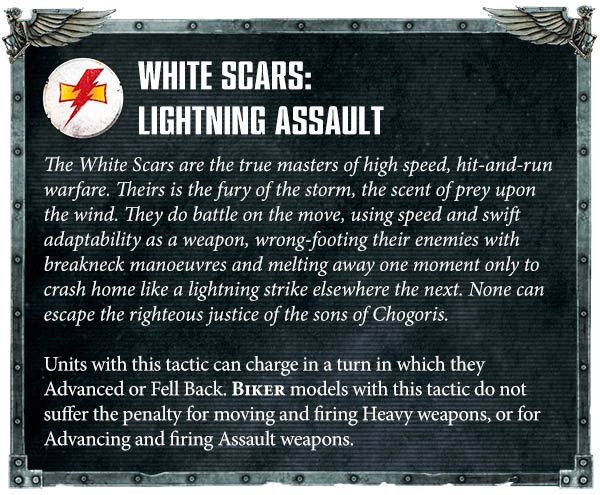8th Edition has not, if we’re honest, been a great time to be a Space Marine player.
Until now.
More than any other faction save Grey Knights, Marines have laboured for the last two years under the dreadful burden of having an early codex. The early days of 8th were a real wild west of game balance as the designers found their feet, and it’s clear looking back on it that some things were drastically overvalued (elite infantry, “conventional” tanks and heavy weapons) and some things were wildly undervalued (hit modifiers and volume infantry). Stratagems took a hard turn from “fun and situationally useful” to “powerful and game-changing” as early as the first Chaos Space Marines book, and the Marine ones have looked distinctly underwhelming ever since. As an army themed around elite infantry and iconic vehicles, Marines got the short end of the stick and things didn’t really get any better as the designers found new and exciting ways to explore 8th’s design space. A few points discounts, some powerful Forge World options and the Codex-warping power of Guilliman himself have let them just about hold up, but it’s been a tough road for loyal adherents of the Adeptus Astartes. Doubly so if Marine players wanted to attempt to make a competitive monofaction army – in recent months that’s been kind of possible, but it’s been very heavily weighted towards taking Guilliman and the best possible tanks to surround him with and maximise his exceptional aura, which is not exactly the kind of army many Marine players envision themselves taking to the table.
That, of course, couldn’t be allowed to stand. Marines are, after all, the poster boy faction of the Warhammer 40,000 franchise. With two years of experience under their belts, GW’s designers have brought us a brand new and massively improved Space Marine Codex, laden with powerful new units, turbo-charged Chapter Tactics and new army-wide mechanics that do new things and fundamentally reshape the army. The Angels of Death are back, everyone. And the Goonhammer review team are here to introduce you to this bold new world where seeing a Marine list across the table from you at a tournament is no longer a cause for relief.
First, let’s lay this out – There’s a lot to talk about. In fact, there’s so much stuff to talk about here that we’re going to have to modify our normal processes somewhat and split this review up into four sections:
- In Part 1, we’re going to cover the army-wide abilities that all the Marines get, the psychic powers, and the Chapter Traits – both the ones you can get by pledging your loyalty to one of 8 famous Chapters and the new “build-your-own” rules.
- In Part 2, we’ll talk about all the new units, and all the existing ones that have notably changed.
- In Part 3, we’ll cover relics, stratagems and warlord traits, plus some wrap up thoughts from our writers.
- In Part 4, we’ll do a deep dive on Forge World units, how they interact with the new rules, and strategies for using them.
If you’ve been paying attention to Warhammer Community over the last two weeks, you’ll also know that as well as the main book, six Chapters are also getting separate Codex Supplements. Each of these will be getting their own article, and we’ll be covering them as they are released, so please check back as they drop pod into action.
As ever, we love to hear your feedback on what we write, and with something as spectacular as this release we’re bound to miss some cool combos or subtle interactions. If you have feedback on this article, or have any questions for us, reach out to us via contact@goonhammer.com or on our Facebook page.
The Army
Summary
Even with their shiny new Primaris units, Space Marines have occupied a weird space in 8th edition 40k. They were clearly pitched as being “elite generalists”, but what has become clear over time is that 8th edition favours specialisation, and outside of a few Guilliman builds Space Marines just haven’t been good enough at anything to excel. Their existing rules also largely fail to hammer home that they’re supposed to be master tacticians – high unit costs left them struggling to generate CP and their stratagems were deeply lacklustre compared to later codices anyway.
The new book represents a wholesale change. Marines have gotten better at everything across the board (which is certainly nice) but perhaps more importantly their new army mechanics and revamped stratagems make them vastly more tactically flexible, allowing you to both create a more specialised army and adapt to situations on the fly – they way the Adeptus Astartes should always have been able to!
Core Rules
The most sweeping changes to the Space Marine army are wrapped up in the Angels of Death special rule, which is an army-wide rule granting all units 3 special abilities (some new, some old) and the Combat Doctrines ability you receive for building a Marine army.
At a unit level, the Angels of Death ability confers the following abilities:
And They Shall No Know Fear
The old standard – Marines get to re-roll their morale tests. This has always been a nice marginal bonus, helping to make it extremely unlikely that your small squads will flee, but has never really stood out, especially compared to morale tricks other armies have. There are a few more compelling reasons to take big units now, so it may see a bit more use, but it’s not really the exciting bit of this.
Bolter Discipline
The Beta Bolters rule from February’s White Dwarf has been finalized and officially applied to Space Marines, who can shoot their Rapid Fire bolt weapons twice from full range (instead of just half) if the whole unit remains stationary or the model is a Terminator, Biker, Centurion, or Dreadnought. It was a strong upgrade when Marines first got it, and it’ll get more chances to shine with the new book – as we’ll see in a second, massed bolter fire looks a lot stronger with the new rules.
Shock Assault
The first big, flashy new toy. Shock Assault gives a unit +1 Attack in any phase in which it makes a charge move, was charged, or performed a Heroic Intervention. This goes a long way to shoring up Marines’ assault capabilities, improving Assault Marines to the point of potentially being worthwhile and making Veteran Intercessors downright scary to deal with in melee. Marine players will find Shock Assault is pretty much always useful, from situations where they need to finish off a target they shot at to when they need to make an opponent regret trying to tie them up in melee combat.
This ability is so good that it made non-codex Marine and Chaos Marine players alike incredibly salty when it was announced, but fortunately for everyone, Games Workshop immediately followed the announcement with another saying that all Marines, loyal or traitor, will be getting the rule. Great stuff, and likely to have some big impacts.
Marine players were already pretty excited after the first few previews showed this off – making every model in the army more deadly is pure upside. However, GW weren’t done with the blanket buffs, and in later previews revealed a second, spectacular buff that levels up the entire army – Combat Doctrines.
Combat Doctrines
Combat Doctrines are a set of three powerful army-wide static buffs that you move through as the game progresses. A Space Marines army starts each game with the Devastator Doctrine active, and then at the start of each battle round after the first, you can opt to change to the Tactical Doctrine. Once you’ve got the Tactical Doctrine active, you can choose to change to the Assault Doctrine at the start of any Battle Round after.
Once you change to a Doctrine, you can’t go back (mostly – there is a once per game stratagem which allows you to shift backwards by one), so Marine armies will always cycle in the order of Devastator > Tactical > Assault, though as we’ll see, some armies may never cycle through them fully. While a Combat Doctrine is active, the entire army gets a benefit to the AP of specific weapons types:
- Devastator Doctrine – Improves the AP of Heavy and Grenade weapons by 1
- Tactical Doctrine – Improves the AP of Rapid Fire and Assault weapons by 1
- Assault Doctrine – Improves the AP of Melee and Pistol weapons by 1
Getting army-wide AP bonuses for specific weapon types is absurdly powerful, to the point that many Marine armies will likely build around being in a particular mode most of the game. It’s worth noting that the rules explicitly state that this AP bonus doesn’t stack with other AP bonuses unless otherwise noted.
There is one major catch to Combat Doctrines: A Marine army only gets access to Combat Doctrines if the entire army has the Angels of Death rule, excepting Servitors and Unaligned units (i.e. fortifications). So if you want the new Marines at their best, soup is off the menu. We’ve always been advocates of incentives for mono-faction armies rather than trying to punish soup, and we think this is a brilliant way of rewarding people who play pure Marine armies. The Doctrines are so powerful (especially the “boosted” versions that specific chapters get in their own books) that we suspect that it will lead to more mono-Marine armies than Marines-in-soup formations, although if combos are found that encourage souping together multiple Marine chapters you’ll still get the “Vanilla” doctrines.
Currently there are some minor legacy rules issues with this. Prior to release, Forge World units didn’t have Angels of Death and would have broken it; luckily Games Workshop planned ahead on this one and released a patch which granted them the rule. The remaining major issue is that, as written, adding an Imperial Assassin to your army with the Operative Requisition Sanctioned stratagem switches off Combat Doctrines. This probably isn’t intended, and we expect to see this patched out quickly (unless a drugged up killer in a bodysuit is meant to be distracting enough to put the Astartes off their game).
Chapter Tactics
We’ll discuss them in more in detail later, but the final nice buff in the core rules is that Chapter Tactics now apply to Space Marine vehicles, not just Infantry, Bikes and Dreadnoughts. This has been desperately needed for a while, and may finally bring Marine vehicles up to the level of those belonging to their various pointy-eared nemeses (Wings note: as if!).

Psychic Powers
Marine psychic powers saw some minor tweaks and updates in the new book, usually on the side of making them slightly more powerful. They also changed their order around on the page for some reason that is strange and alien to us.
Librarius Discipline
The Librarius discipline gets some minor tweaks, but on the whole remains kind of middling in terms of what it brings to the table for your psykers. We’ll go through what they do in the order they appear in the new codex, and then assign them a letter grade at the end of each power.
- Veil of Time (WC 6). Affects a <CHAPTER> unit within 18″. Until your next Psychic phase, that unit can re-roll Advance and Charge rolls, and always fights first in the Fight phase, even if it did not charge. A solid ability when paired with the Hungry for Battle Chapter Tactic (below), and you want to try and make those 8″ Deep Strike charges, where being able to re-roll a failed result ups your chances of making an 8″ charge to 83% without spending CP. B
- Might of Heroes (WC 6). Affects a <CHAPTER> model within 12″. Until the start of your next Psychic phase, that model gets +1 Strength, +1 Toughness, and +1 Attack. Helpful for boosting dreadnoughts and other heroes (like Guilliman) to insane damage output levels. B
- Null Zone (WC 7). Until the start of your next psychic phase, enemy units can’t make invulnerable saves while they are within 6″ of the psyker, and when a Psychic test is taken for an enemy model within 6″, the result is halved. Null Zone’s difficulty got reduced by 1 in the new book, which helps, but it’s still difficult to use, as it demands your psyker be within hitting distance of the unit/s whose save you’re trying to deactivate. In a tournament environment, you’ll likely get the most value out of this against Chaos Daemon hordes, where removing their 5+ invulnerable saves and blocking psychic powers can be a real pain. The best platform for this is a jump pack Librarian. B
- Psychic Scourge (WC 6). Choose an enemy unit within 18″ and roll a D6, then add your Ld value. Your opponent does the same. If you score higher, that unit takes D3 mortal wounds. If you score equal, they take 1 mortal wound. Basically a worse Smite, and not something we’re going to use very often. It’s slightly better for Ultramarines since their Chapter Tactic gives them a +1 boost to Ld, but there are almost always going to be other powers you’d rather use. D
- Fury of the Ancients (WC 7). Select a visible enemy model within 12″ of the psyker and draw an imaginary straight line between the two, each unit under the line takes a mortal wound. This one is improved over its prior iteration where it was 3D6″ range and had more variance (which is usually bad), but it’s still going to be a worse smite most of the time. D
- Psychic Fortress (WC 5). Select a friendly ADEPTUS ASTARTES unit within 18″ of the psyker. Until the start of your next psychic phase, that unit automatically passes morale tests and if it would lose a wound from a mortal wound in the psychic phase, roll a D6; on a 4+ it doesn’t lose that wound. The morale test part hardly matters but the ability to protect a unit from Smite-happy armies still has some value. Really, using this will be more about shunting your opponent’s Smites onto a different target rather than actually rolling the saves, but because Smite has to target the closest unit you can set up some nice defensive play with this. C
Obscuration Discipline
The big change to Obscuration is that now most of the powers affect <CHAPTER> PHOBOS units instead of ADEPTUS ASTARTES PHOBOS, adding a further gate to attempts to mix and match Chapter Tactics within an army. On the whole, these are better powers than the Librarius Discipline, and got better with the new Phobos units entering the mix, where we have some quality targets to throw them on. The biggest benefit to this discipline is that all of its powers have a Warp Charge cost of 6, so they’re all pretty easy to cast.
- Shrouding (WC 6). Pick a friendly <CHAPTER> Phobos unit within 18″ of the psyker. Until the start of your next psychic phase, enemies can only shoot at that unit if it’s the closest visible target or they’re firing Overwatch. A strong effect, but it can potentially be at odds with the notion that your Phobos-armored units may be closer than the rest of the army. Its best use is protecting Eliminators, who are going to be high-value targets for enemy fire. B
- Soul Sight (WC 6). Pick a friendly <CHAPTER> Phobos unit within 18″. Until the start of your next Psychic phase, when that unit shoots, it can re-roll the hit roll and the units it targets do not get the benefit of cover to their saving throws. This one hasn’t changed either, but picked up more utility from Eliminators becoming even better. Works well paired with either of bolt sniper rifles and las-fusils. A
- Mind Raid (WC 6). Pick a visible enemy model within 18″ of the psyker. It takes a mortal wound. If your army is Battle-Forged and the model is a CHARACTER, roll 3D6. If you roll equal to or above its Leadership characteristic, you get 1 Command Point. An interesting ability that hasn’t changed much, the big problem with Mind Raid is that most of the time you’re just going to have better stuff to do and getting within 18″ of an enemy character may just not be what you want your Phobos Librarian doing. C
- Hallucination (WC 6). Pick a visible enemy unit within 18″ of the psyker. It gets -1 to its Ld and your opponent rolls 2D6. If the result is higher than the unit’s Ld, that unit suffers a -1 to its hit rolls until the start of your next psychic phase. This is another potentially solid ability that mimics the Dark Angel and Space Wolves powers to degrade enemy hit rolls, but runs a dangerous risk of doing nothing at all a lot of the time. C
- Tenebrous Curse (WC 6). Pick a visible enemy unit within 18″ that doesn’t have the FLY keyword. It takes a mortal wound and its Movement stat, Advance, and Charge rolls are halved until the start of your next psychic phase. Thanks to the various Chaos monstrosities currently stomping about the metagame this can be extremely potent in some matchups, but is also incredibly dead in others. Pick it when it’s good. B / E (based on matchup)
- Temporal Corridor (WC 6). Pick a friendly <CHAPTER> Phobos unit within 3″. It can move as though it was the Movement phase. It can’t Fall Back and must Advance, and when it does, you roll 3D6 and discard two of the rolls. You can’t use this on a unit more than once in a Psychic phase. At first glance this feels like a loyalist Warptime, but the Phobos and Advance restrictions really take a lot of the wind out from under its sails. It’s still a big jump, but the units who get the most out of it will want to charge or fire some Assault weapons afterward, and that means where this power really shines is for White Scars (as we’ll see shortly) or for bolt carbine Reivers using the Rapid Assault Chapter Tactic. B
Chapter Tactics
Chapter Tactics are back, and greatly improved. They now apply to all units in a Space Marines detachment (not just Infantry, Bikers, and Dreadnoughts), meaning that tanks, aircraft, and speeders will also get access to them. This won’t matter for many of the Chapter Tactics we’ll look at, but there are a few areas where it’ll be extremely powerful. We’ve split this section to look at the 8 “main” chapter tactics and the build-a-chapter Successor rules separately.
The 8 “Main” Chapter Tactics
We wanted to refer to these as the “First Founding” chapters, but this list also includes two successor chapters, so we’ll refer to them as the 8 main tactics for now. Essentially each one of these has been upgraded to incorporate two abilities, usually improving on the Chapter’s rules from the older codex.
Black Templars
The Black Templars get a huge boost from their old Chapter Tactic. Now being able to re-roll a single die on their charge attempts instead of being forced to re-roll both gives a slight improvement in odds – see our article on probability for more on how re-rolls affect charge distances. The short version of it is that having this ability gives them about 58% odds of making a 9″ charge, which is OK but not large enough to bet the farm on. They also picked up the ability to negate mortal wounds on a 5+, a nifty bonus that helps to make up for their inability to negate enemy psychic powers with Librarians. It’s a step up, but we’re not quite convinced it’s worth giving up access to psychic powers completely and comparatively it’s one of the weaker Chapter Tactics. Even the ability to ignore mortal wounds may only be situationally useful given that most of the psychic powers that cause you real problems don’t cause mortal wounds (although there are lists that lean on them, notably the Tsons/Nurgle list). Ultimately the Black Templars still got the short end of the stick, but it’s a mark of how much more generous that stick is that they still look a lot more appealing than they did!
Crimson Fists
The Crimson Fists get an updated version of their Chapter Trait from White Dwarf, modifying the conditions of their hit roll bonus to apply when shooting at a unit with 5+ more models than their own instead of having twice as many models or more. Additionally, they’ve regained the Imperial Fists ability of getting an extra hit if they roll an umodified 6 to hit when shooting bolt weapons. It’s a moderate step up but potentially not enough to make them a real contender among Chapter Tactics because of how conditional it is, although it makes working through hordes much more feasible for smaller squads (and Aggressors absolutely excel).
Where it’s really going to shine is on vehicles, where a lot of guns on what essentially counts as 5 models can put a real hurt on hordes when that +1 to hit bonus gets applied.
Finally (and appropriately) it does let characters armed with power fists wade through infantry like no one’s business, as it offsets the negative hit modifier.
Math Note: On average, a 5-man squad of Intercessors with this trait rapid-firing into a mob of 20 Ork Boyz will kill 1.66 extra models than a squad without this trait (5 with, 3.33 without). When you’re in these ideal conditions the 50% damage boost is really nice, but the problem compared to some of the competition is that its restricted to certain weapons and situations.
Mind you, Crimson Fists being 50% better at wasting Ork hordes does stand out as one of the bigger fluff wins in the book.
Imperial Fists
The boys in yellow keep their ability to ignore cover bonuses and add on a built-in Bolter Drill rule for extra hits on unmodified rolls of a 6 to hit with bolter weapons. Lower key than some of the other abilities, but stronger than it seems – the combination of this now applying to vehicles and the Devastator doctrine means that armies like Guard (and indeed other Marines) who often lean on Prepared Positions to bump up the survivability of their key targets turn one are going to have real headaches against this. Just like for Crimson Fists, the bolter bonus is fun when stacked with other similar abilities (such as the Liberators stratagem for the Indomitus Crusaders detachment) that will allow you to proc more additional hits, but remains more of a nice-to-have than something reliable enough to really build around.
Iron Hands
Iron Hands keep their army-wide “Feel No Pain” ability to ignore wounds on a 6+, and get an added bonus of hitting on a 5 or 6 in Overwatch and counting as double their existing wounds total for the purposes of vehicle damage brackets. This is one of the stronger traits and the combination immediately makes Iron Hands the go-to for running vehicles, since they’ll not only be harder to kill but also operating at full effectiveness for longer. We’ll have to wait and see what else Iron Hands get (we know there’s a Primaris Iron Father character in the pipeline so a Codex of their own seems like a given), but this trait puts them on track to be real contenders.
Math Notes: On average, a 6+ ignore wounds roll works out to 1 extra wound for every 6 a vehicle has, meaning that your Repulsor Executioners will feel more like they have 18-19 wounds and will keep their top profiles until they only have 4 wounds remaining.
Raven Guard
The Raven Guard were the only Chapter that saw a nerf to its Chapter Tactic, in part because an army-wide -1 to be hit applying to vehicles has been thoroughly proven to be a horrible mistake (Wings note: whistles innocently). The new trait gives units more than 12″ away the benefit of cover instead (something that makes traits like the Imperial Fists’ and Iron Warriors’ more useful), and gives them -1 to be hit if they are not a Vehicle and already in cover and more than 12″ away. Overall, though it’s technically a weaker ability than what they had (it certainly no longer feels like the definite “best” trait), it’s also one where extending it to vehicles (even just the cover bit) is extremely powerful. This is still definitely a strong one. It’ll also save you 2 CP for Prepared Positions in half your games.
Salamanders
The Salamanders get an improved version of their re-rolls that now gives them a re-roll to wound each time one of their units shoots or fights, plus they get to treat AP -1 weapons as AP 0, combining the Thousand Sons’ ability with the Deathskulls. Fluff-wise, it’s an interesting combo that represents them having artisan weapons and armor, though we wish they’d allowed for shot count re-rolls as well to reflect the flamecraft ability of Salamanders. Rules-wise, it’s a very strong combination that really smooths out Salamanders’ damage output and ensures Salamanders players will be able to spend their re-roll CP elsewhere. It’s also another one that’s incredibly welcome now it’s been rolled out to vehicles.
Ultramarines
The Ultramarines get to keep their Leadership bonus and the ability to shoot with any unit after they Fall Back, albeit with a -1 to hit penalty. This ability was already very good, but being able to fall back and shoot with tanks elevates the ability to full-on god tier. Now Ultramarines no longer have to fear opponents disabling their tanks by tagging them up in melee – they can just casually reverse away from the foe and then proceed to shoot them in the face. In addition to their Chapter Tactic, Ultramarines are getting their own Codex supplement which gives them additional benefits and rules. Combine that with Roboute Guilliman still being incredibly strong (despite a slight nerf, more on that in our review of Codex: Ultramarines) and Ultramarines already have a very strong case for being the strongest Space Marine chapter.
White Scars
White Scars get the ability to charge in the same turn after they Advance or Fall Back, giving them incredible mobility for their combat units and the ability to trade off a round of Overwatch shooting any given turn for an additional attack from Shock Assault re-triggering. White Scars bikes also get to ignore the penalties for moving and firing Heavy weapons and Advancing and firing Assault weapons. The bike bonuses are cool, but relatively minor compared to the advance/charge; the only heavy weapons bikes get are heavy bolters and multi-meltas on Attack Bikes, neither of which is really worth paying for (not to mention the hassle of assembling the kit) even ignoring the penalty. The ability to Advance and fire Assault weapons likewise really only applies to meltaguns on bike units, which has some niche uses though most of the time you’ll want to use your bikes for their ability to put out 4 shots each with Bolter Discipline. Still, we know there are some old-school White Scars players out there sitting on Attack Bike Squadrons excitedly raising their fists into the air shouting “MY TIME HAS COME!” over this, so we’re happy for them.
On a more serious note, jump pack and bike characters who want to tangle in melee look really appealing with this. Obviously Wolves and Blood Angels still have great support for them, but the extra mobility means that White Scars are going to be one of the better ways to do this within Codex Marines.
The Successor Chapter Tactics
In addition to the tactics for the 8 “main” Marine factions (which will presumably be covered in upcoming Codex Supplements), Games Workshop took a page out of its 4th edition playbook and released an updated system for making your own custom rules for Successor Chapters. The system is pretty simple: Instead of taking one of the defined chapters, you build your own Successor Chapter with its own subfaction keword, and instead of using another chapter’s trait, you pick two from the list of Successor Chapter Tactics. Most of these replicate half of the main Chapters’ tactics and power-wise they range from “Meh” to “Decent” but there are a few stand-outs and combinations that work well.
On a casual note, these are great; as a long-time player of a successor chapter, they give players like me a chance to create custom rules that fit my idea of what the chapter does. It’s a welcome return from older days, and something I wish they’d implemented for Chaos Space Marines back in April.
A Competitive Note
Now, there’s a really important note about these that makes them worth seriously sitting up and paying attention to. Up until now in 8th edition, using a non-“named” chapter (or equivalent for other factions) and picking a trait has technically been strictly worse than actually using the named chapter, as RAW you don’t get access to the warlord traits, stratagems, characters, and relics that a named chapter would give you. To mitigate this, in tournament play people have generally just picked one of the named keywords even if they’ve painted their models homebrew, so non-standard chapters haven’t factored in much on the big stage. Given that there are whole separate supplements with additional rules for six chapters, people familiar to this paradigm could be forgiven for immediately writing off this section as “fluff” for the fans.
Don’t. This release marks a huge shift in how this is handled in the rules, with some significant implications. When you create a successor chapter from this list, you can choose one of the six first founding chapters (so the list above excluding Black Templars and Crimson Fists) to be descended from. Scooting ahead and checking the wording on the special abilities section in the Ultramarines book, a successor chapter that has selected Ultramarines as their founding chapter gets access to almost all of the benefits that Ultramarines do – the special Doctrine (more on that when we hit the supplements), the stratagems, warlord traits, and psychic powers and the “lower” tier relics (again, see our later review). The only restriction on this is that in order to get some of the army-wide first-founding abilities (such as Scions of Guilliman), every unit in your army has to be from the same Chapter.
The Successor Tactics
That’s a big deal, because it means that if any of the abilities below turns out to be especially potent with the unique toys in one of the supplements, you could be looking at some astoundingly powerful combinations. So without further ado, let’s take a look at the successor tactics:
- Bolter Fusillade. Re-roll To Hit rolls of 1 on bolter weapons. A somewhat interesting ability that allows your Intercessors and Tactical Marines to range free from their Captains, and just go harder on Lieutenants instead. However, you’ll probably find you want to take buff characters anyway, leaving this a marginal boost at best. C
- Born Heroes. Characters get a 6″ Heroic Intervention move. Useful for managing your backline battle piles with key characters, but there are stronger options. D
- Duellists. When fighting in melee against infantry or bikers, unmodified To Hit rolls of a 6 always hits and automatically scores a Wound. Can’t be combined with Whirlwind of Rage. Helps pretty much everything go through hordes more efficiently, but the limited scope of targets makes it a lot less appealing than Whirlwind of Rage. Would be more useful if there were more high toughness infantry out there to fight. C
- Fearsome Aspect. Enemy units within 3″ get a -1 modifier to their Leadership. Ultimately not that useful – just ask the Night Lords how often this one works out, and theirs actually stacks up to a -3. D
- Hungry for Battle. Units with this trait get +1 to their Advance and Charge rolls. Incredibly useful, particularly if you are trying to make charges out of deep strike, where even a 1″ difference bumps your odds up to 42% before considering re-rolls. It’s going to be a must-have for combat-focused armies. A

- Inheritors of the Primarch. You give up the ability to choose a second tactic but instead you get to pick one of the First Founding Chapter Tactics instead. This locks you in to designating yourself a successor of that chapter. If this was the only way to get your custom chapter access to the supplement rules it would be worth it. It would also be interesting if it let you take one of the “core” chapter tactics across to a successor of another chapter. Sadly, it does neither, so is ultimately a bit pointless. D
- Knowledge is Power. Re-roll any or all dice rolls of a 1 when attempting to manifest or deny a psychic power. Helpful for avoiding Perils of the Warp and smoothing out psychic results, but ultimately not as good as having a +1. Also only applies to a few units in the army, and Librarians still aren’t the Marines’ strong suit. C
- Long-range Marksmen. Add 3″ to the range characteristic of ranged weapons for units with this tactic. An interesting ability but one that we worry doesn’t quite do enough in terms of full impact. Adding 3″ to 30″ or 24″ guns isn’t quite enough to make a significant different in tactics, nor is +1.5″ on Rapid fire range. Where this can potentially get silly is with flame weapons and guns that normally top out at 18″. Having flamers give you an 11″ radius of “charge me and get wrecked” or which can shoot out of deep strike is pretty funny, but its best use is going to be on Aggressors’ flamestorm gauntlets, where having only 11″ range is still going to make you wish you were using the boltstorm gauntlets instead (though upping those to 21″ isn’t a bad trade-off). Ultimately it’s one of the more interesting abilities but kept intentionally on the lower side with regard to power level, and that’s probably a smart move. B
- Master Artisans. When a unit with this trait fights, fires Overwatch, or shoots in the shooting phase, you can re-roll one hit and one Wound roll for them. Basically the first (and better) half of the Salamanders’ Tactic. It’s an extremely strong ability to be able to tack onto a unit, and just makes everything better. It just helps smooth your entire army and is a solid contender for the best Successor Tactic. Wings Note: it’s also on my watch list for “most likely thing to be a bit much when combined with a supplement” A
- Preferred Enemy. When you select this tactic, choose one of Tyranids, Aeldari, Orks, Heretic Astartes, Necrons, or T’au Empire. When resolving an attack made by a melee weapon against a unit with that keyword, in the same turn you charged, were charged, or made a Heroic Intervention, you can re-roll the result. This is just a bad rule. It’s absurdly specific, requiring many hoops to jump through to see in action, and it’s focused entirely on one enemy faction. I see what they’re going for here from a fluff standpoint, trying to create stories for Chapters that have old rivalries against a particular foe, but it just doesn’t work. In my mind, it’s the worst kind of rule: In a tournament, it won’t be do enough to be worth taking, and in casual play, any time you take this it’s going to feel like you are tailoring your list to fight a specific opponent. It doesn’t work for either kind of play. F
- Rapid Assault. Units with this tactic don’t suffer the penalty from Advancing and shooting Assault weapons. This is a neat ability. The big challenge here is that Marines just don’t have many Assault weapons. Your list is essentially flamers and other flame weapons, for which the penalty doesn’t matter, meltaguns, which are expensive and short-ranged, bolt carbines, assault plasma incinerators, which are unfortunately Strength 6, and auto bolt rifles (yes, there are more options, but those are the most common). I think the key thing here to build around is auto bolt rifles, where the trade-off in range for shots can be mitigated by advancing each turn to get additional mobility out of your army. This effectively gives you a slightly fewer shots than standing still with the regular bolt rifle, but enables you to move in and out of range more freely and grab objectives. Overall we think it’s a more powerful ability than people will initially realize, but it requires building around in a way that some other tactics do not. A
- Scions of the Forge. Models with this trait that have a damage table always count as having twice the number of wounds remaining for the purposes of their stats on the table. Gives you half of the Iron Hands’ Tactic, which can theoretically be useful if you’re going heavy on forward vehicles for your fire base. However, Marine vehicles tend to exist in a binary state of “alive” or “violently exploded”, and the fact that it does nothing for your Infantry makes it a probable miss. C
- Stalwart. When rolling To Wound rolls for attacks against models with this trait, an unmodified roll of a 1 or 2 always fails, irrespective of the Strength or abilities of the attacker. This is basically what Blood Ravens just got and it’s a good Infantry-focused mirror to Scions of the Forge. If you read our Blood Ravens article, you know that our take on this ability is that it does the most good on T4 units with multiple wounds, who are most vulnerable to multi-damage S8+ weapons. So if you’re running this, plan to run a lot of Primaris Infantry. B
- Stealthy. Units with this Tactic count as having the benefit of cover for their saves when being attacked from more than 12″ away with ranged weapons. A strong power-up that almost any unit in the army will benefit from, and the number of abilities that ignore or deny you cover penalties isn’t that large. You’ll have to worry mostly about Imperial Fists, I guess. A
- Stoic. Units with this ability add 1 to their Leadership characteristic. This is just not something Marines need. F
- Tactical Withdrawal. Units with this tactic can charge in the same turn in which they make a Fall Back move. A strong upgrade that allows all of your melee units to risk another volley of overwatch fire in exchange for an extra attack, or to just adjust your targets. Very helpful for jump infantry, who can use their Fall Back moves to jump over the screens they ran into one turn prior. Also great if you’re building a coven of Smash Captains (although there may be some minor issues with that thanks to point hikes). Needs to be built around, but it’s well worth it. B
- Warded. When a model with this Tactic suffers a mortal wound, it can roll a D6, and on a 5+ that wound is negated. A neat ability if you’re going up against lots of Smites, but ultimately very situational and not strong enough to take over the other options unless mortal wounds become much more common in the meta. D
- Whirlwind of Rage. In the combat after a model with this Tactic has charged, was charged, or made a Heroic Intervention, when rolling its attacks, any unmodified to hit roll of a 6 causes an additional hit. Can’t be combined with Duellists. As-is, it’s a very nice ability to add on to any of the other combat-centric Successor Traits (Hungry for Battle, Tactical Withdrawal, Rapid Assault). The fact that this doesn’t have any targeting restrictions (unlike Duellists) makes it a much more appealing general choice, although it’s at its best on powerful characters or things like Dreadnoughts where every extra attack counts. A solid choice if you want to get into melee. B
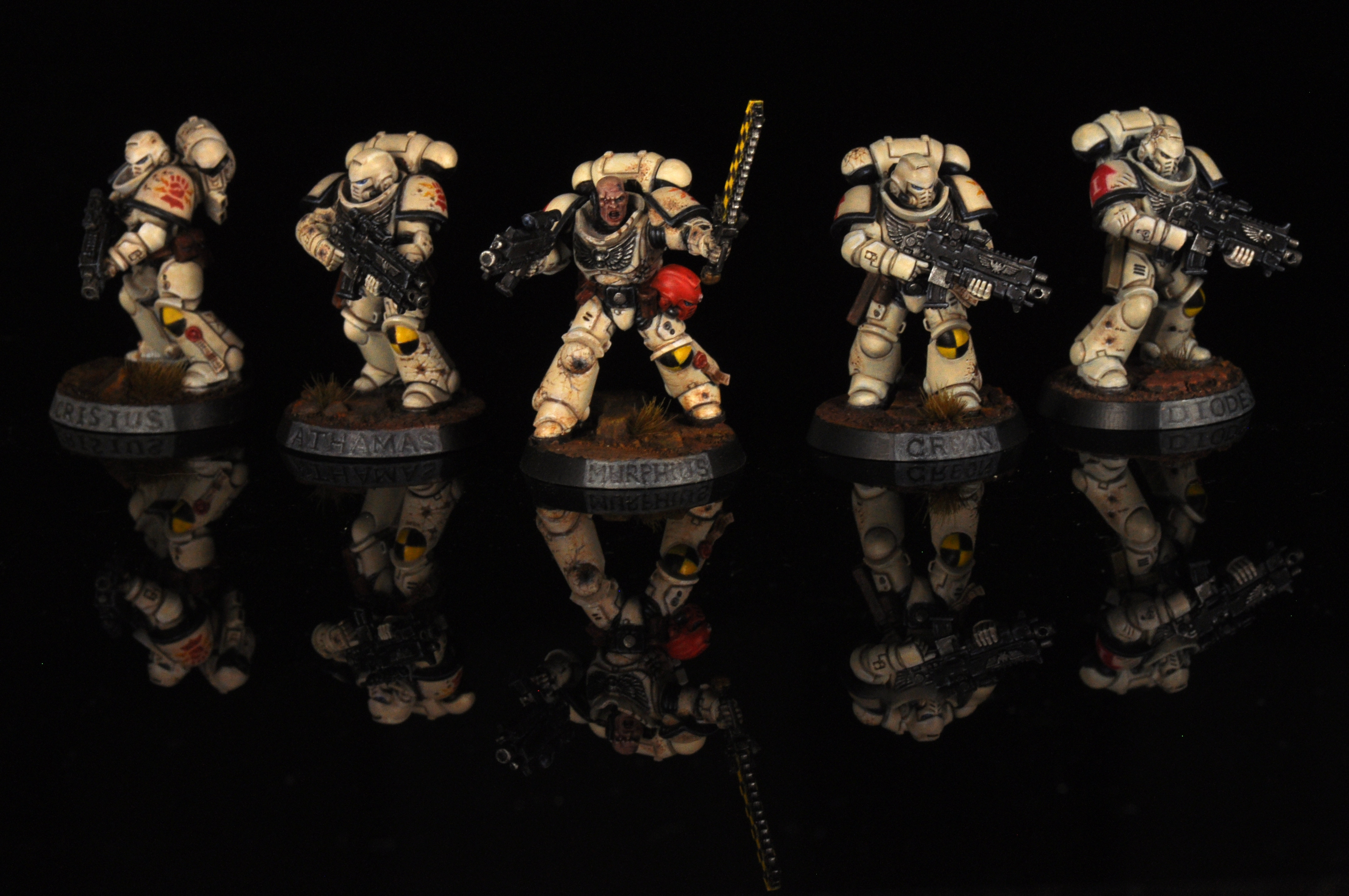
Combining These Tactics
After looking at these, there are a few combinations that stick out to us:
- Rapid Assault and Bolter Fusillade/Long-Range Marksmen – The plan here is to double down on auto bolt rifles, with which we can advance every turn for an average 9″ move, while still pouring out 3 shots per model and re-rolling to hit rolls of 1. The focus here is on mobile squads of Intercessors with some support from Hellblasters with assault plasma incinerators and using the Tactical Doctrine to ensure that the squad is getting the extra AP bonus on their guns. Alternatively, I might look at Long-Range Marksmen here to make up for the lost range on our gun choices, though I think Bolter Fusillade is probably the way to go.
- Stalwart and Stealthy – For when we want our lads to be as tough as they can possibly be by default. Another combination that’s going to want Primaris infantry, our boys will be running around with a 2+ save and shrugging off one third of heavy weapon shots sent their way or more. This combo also doesn’t require us to think as much about how we’re using our dudes, just as long as we’re keeping them away from some of the tougher targets and daring the enemy to charge us and get Shock Assaulted back into the Age of Strife.
- Whirlwind of Rage and Hungry for Battle/Tactical Withdrawal – This is the combo I’d lean toward if I were building a melee-focused army. The +1 to charge rolls from Hungry for Battle helps you make charges out of Deep Strike and ensures you’ll be able to close distances more readily, while Tactical Withdrawal lets you repeatedly charge enemy units or move through screens. Whirlwind of Rage improves your output. Here I’m gonna go either heavy on Veteran Intercessors or Assault Marines, using the ability to press forward quickly and drop an assload of attacks on enemy units that will turn into automatic wounds even against harsher targets. With this list our biggest challenge is going to be that we can’t go into Assault Doctrine until Battle Round 3, so we’ll either want to hold the Assault marines in orbit a turn, or focus on protecting them until they can strike.
- Master Artisans and Stealthy – This is just combining two strong benefits. You up your survivability against shooting attacks, and smooth out your rolls army-wide. This is exceptional if any of the supplements lend themselves to a vehicle gunline.
- Scions of the Forge and Whirlwind of Rage – This is what I’d run for an extremely silly melee Contemptor army.
…And on to the Main Event
That’s the end of part 1 of this review. Move on to part 2 for the units, or if you’re planning to take your existing collection out on to the field and want to know which stratagems to use with them, take a look at part 3 (going live Sunday at 9AM EDT). And if you want to read more about the Space Marines Forge World units and how the new Codex affects them, check out part 4.
